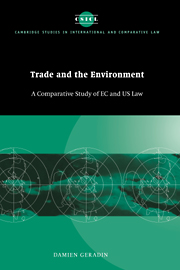Book contents
- Frontmatter
- Contents
- Preface
- Table of cases
- Table of legislation
- List of abbreviations
- Introduction
- PART 1 NEGATIVE HARMONIZATION
- 1 The case law of the Court of Justice
- 2 The case law of the Supreme Court
- 3 Comparative analysis
- 4 Judicial and legislative intervention
- PART 2 POSITIVE HARMONIZATION
- Conclusion
- Bibliography
- Index
- CAMBRIDGE STUDIES IN INTERNATIONAL AND COMPARATIVE LAW
3 - Comparative analysis
Published online by Cambridge University Press: 29 September 2009
- Frontmatter
- Contents
- Preface
- Table of cases
- Table of legislation
- List of abbreviations
- Introduction
- PART 1 NEGATIVE HARMONIZATION
- 1 The case law of the Court of Justice
- 2 The case law of the Supreme Court
- 3 Comparative analysis
- 4 Judicial and legislative intervention
- PART 2 POSITIVE HARMONIZATION
- Conclusion
- Bibliography
- Index
- CAMBRIDGE STUDIES IN INTERNATIONAL AND COMPARATIVE LAW
Summary
The principle of free-trade
With regard to the free movement of goods, the US Constitution and the EC Treaty present similarities but also differences. In the EC Treaty, there is no grant of power to the Community similar to the general power conferred on the Congress by the Commerce Clause. In fact, the EC Treaty starts the other way round: instead of a grant of power to the Community which would by the same token limit to a certain extent the power of the member states to interfere with intra-Community trade, it provides for express prohibitions for the member states to impose quantitative restrictions on imports or exports or measures having an equivalent effect between member states. Thus, one may question whether the two situations are comparable. At least, the context is similar. In both cases, the major incentive for creating a union was the desire to avoid destructive state protectionist policies, coupled with the ambition of creating a common market stretching over the territories of all the states involved in the unitary process.
As a result of this common object, the jurisprudence of the two courts has developed in very similar ways. There are important similarities in the principles both courts have developed for placing restrictions on state legislation that would impede the free movement of goods. Similarly, there are many parallels in the methods that the courts employ for determining the limits of state power.
- Type
- Chapter
- Information
- Trade and the EnvironmentA Comparative Study of EC and US Law, pp. 53 - 66Publisher: Cambridge University PressPrint publication year: 1997



